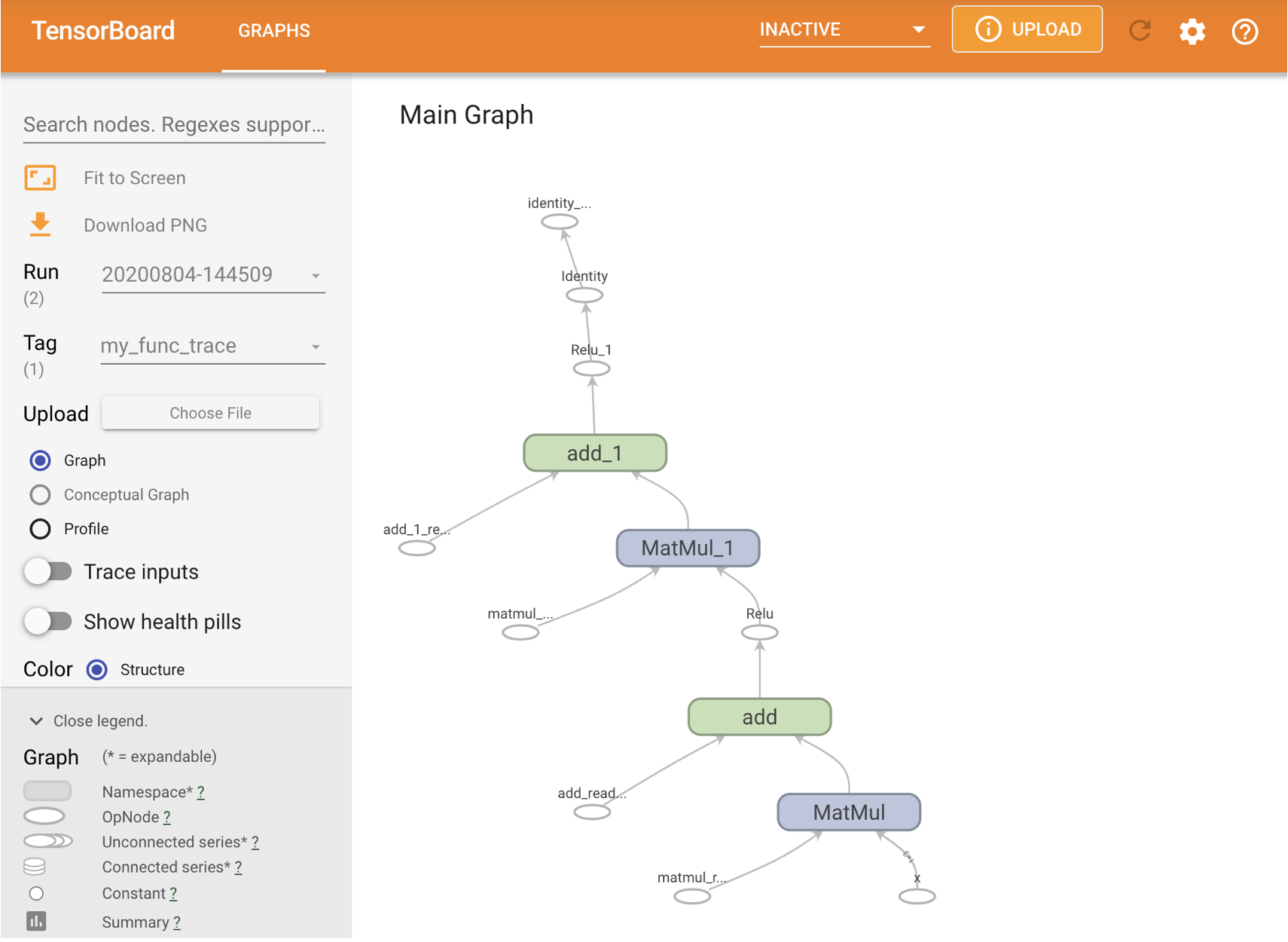TensorFlow(五)Module & Layer
本章介绍如何利用TF中的Module和Layer构建模型Model。
Model在TF中的定义:
- 可以用来计算Tensor的函数(前向传递)
- 含有一些可以用于训练的变量
Module
大多数模型可以视为Layer的集合,在TensorFlow中常用的Keras和Sonnet,都基于tf.Module,这样一个模型构建基类。
下面是一个简单的Module案例:
class SimpleModule(tf.Module):
def __init__(self, name=None):
super().__init__(name=name)
self.a_variable = tf.Variable(5.0, name="train_me")
self.non_trainable_variable = tf.Variable(5.0, trainable=False, name="do_not_train_me")
def __call__(self, x):
return self.a_variable * x + self.non_trainable_variable
simple_module = SimpleModule(name="simple")
simple_module(tf.constant(5.0))
<tf.Tensor: shape=(), dtype=float32, numpy=30.0>
所有定义在Module中的tf.Variable可以通过下面的方法调出来:
# All trainable variables
print("trainable variables:", simple_module.trainable_variables)
# Every variable
print("all variables:", simple_module.variables)
trainable variables: (<tf.Variable 'train_me:0' shape=() dtype=float32, numpy=5.0>,)
all variables: (<tf.Variable 'train_me:0' shape=() dtype=float32, numpy=5.0>, <tf.Variable 'do_not_train_me:0' shape=() dtype=float32, numpy=5.0>)
下面的例子是一个2层的模型:
class Dense(tf.Module):
def __init__(self, in_features, out_features, name=None):
super().__init__(name=name)
self.w = tf.Variable(
tf.random.normal([in_features, out_features]), name='w')
self.b = tf.Variable(tf.zeros([out_features]), name='b')
def __call__(self, x):
y = tf.matmul(x, self.w) + self.b
return tf.nn.relu(y)
class SequentialModule(tf.Module):
def __init__(self, name=None):
super().__init__(name=name)
self.dense_1 = Dense(in_features=3, out_features=3)
self.dense_2 = Dense(in_features=3, out_features=2)
def __call__(self, x):
x = self.dense_1(x)
return self.dense_2(x)
# You have made a model!
my_model = SequentialModule(name="the_model")
# Call it, with random results
print("Model results:", my_model(tf.constant([[2.0, 2.0, 2.0]])))
print("Submodules:", my_model.submodules)
print("Variables:")
for var in my_model.variables:
print(var)
Model results: tf.Tensor([[0.726721 0. ]], shape=(1, 2), dtype=float32)
Submodules: (<main.Dense object at 0x14ff72220>, <main.Dense object at 0x14ff72940>)
Variables:
<tf.Variable 'b:0' shape=(3,) dtype=float32, numpy=array([0., 0., 0.], dtype=float32)>
<tf.Variable 'w:0' shape=(3, 3) dtype=float32, numpy=
array([[-0.04521921, -1.0091199 , 0.9258913 ],
[-1.3478986 , 1.3179303 , 1.1542516 ],
[-1.6228262 , -0.27181062, -1.7817621 ]], dtype=float32)>
<tf.Variable 'b:0' shape=(2,) dtype=float32, numpy=array([0., 0.], dtype=float32)>
<tf.Variable 'w:0' shape=(3, 2) dtype=float32, numpy=
array([[-1.4439265 , -1.1323329 ],
[ 0.42235672, -0.17511047],
[ 1.165401 , -1.1133528 ]], dtype=float32)>
class FlexibleDenseModule(tf.Module):
# Note: No need for `in_features`
def __init__(self, out_features, name=None):
super().__init__(name=name)
self.is_built = False
self.out_features = out_features
def __call__(self, x):
# Create variables on first call.
if not self.is_built:
self.w = tf.Variable(
tf.random.normal([x.shape[-1], self.out_features]), name='w')
self.b = tf.Variable(tf.zeros([self.out_features]), name='b')
self.is_built = True
y = tf.matmul(x, self.w) + self.b
return tf.nn.relu(y)
存储Weights和Function
储存权重
在模型训练结束后,训练出的权重和function可以用TF储存,步骤如下:
chkp_path = "my_checkpoint"
checkpoint = tf.train.Checkpoint(model=my_model)
checkpoint.write(chkp_path)
'my_checkpoint'
可以通过这个方法查看:
tf.train.list_variables(chkp_path)
[('_CHECKPOINTABLE_OBJECT_GRAPH', []),
('model/dense_1/b/.ATTRIBUTES/VARIABLE_VALUE', [3]),
('model/dense_1/w/.ATTRIBUTES/VARIABLE_VALUE', [3, 3]),
('model/dense_2/b/.ATTRIBUTES/VARIABLE_VALUE', [2]),
('model/dense_2/w/.ATTRIBUTES/VARIABLE_VALUE', [3, 2])]
用restore()方法,也可以复写它:
new_model = MySequentialModule()
new_checkpoint = tf.train.Checkpoint(model=new_model)
new_checkpoint.restore("my_checkpoint")
# Should be the same result as above
new_model(tf.constant([[2.0, 2.0, 2.0]]))
<tf.Tensor: shape=(1, 2), dtype=float32, numpy=array([[4.0598335, 0. ]], dtype=float32)>
储存方法
下面的示例是方法的存储:
定义一个Module(用graph提高效率)
class MySequentialModule(tf.Module):
def __init__(self, name=None):
super().__init__(name=name)
self.dense_1 = Dense(in_features=3, out_features=3)
self.dense_2 = Dense(in_features=3, out_features=2)
@tf.function
def __call__(self, x):
x = self.dense_1(x)
return self.dense_2(x)
# You have made a model with a graph!
my_model = MySequentialModule(name="the_model")
可以用tensorboard来看这个模型:
# Set up logging.
stamp = datetime.now().strftime("%Y%m%d-%H%M%S")
logdir = "logs/func/%s" % stamp
writer = tf.summary.create_file_writer(logdir)
# Create a new model to get a fresh trace
# Otherwise the summary will not see the graph.
new_model = MySequentialModule()
# Bracket the function call with
# tf.summary.trace_on() and tf.summary.trace_export().
tf.summary.trace_on(graph=True)
tf.profiler.experimental.start(logdir)
# Call only one tf.function when tracing.
z = print(new_model(tf.constant([[2.0, 2.0, 2.0]])))
with writer.as_default():
tf.summary.trace_export(
name="my_func_trace",
step=0,
profiler_outdir=logdir)

存储:
tf.saved_model.save(my_model, "the_saved_model")
会生成如下3个文件:
- assets
- pb: 描述graph的缓存
- variables
载入并通过 isinstance()查看是否是之前定义过的模型:
new_model = tf.saved_model.load("the_saved_model")
print(isinstance(new_model, SequentialModule))


 浙公网安备 33010602011771号
浙公网安备 33010602011771号